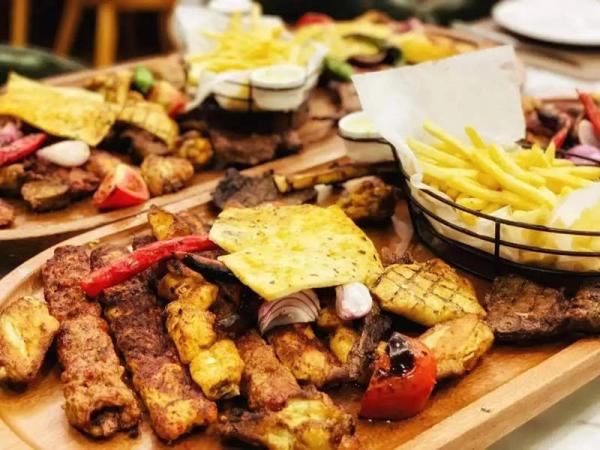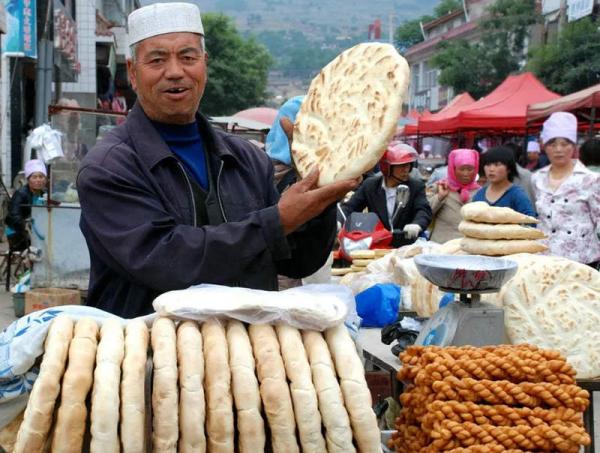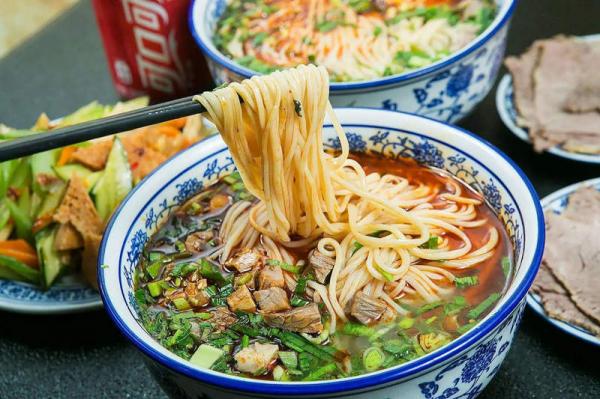Halal Food in China
China boasts a large Muslim population (nearly 30 m), they all have the tradition of consuming the Halal food for a long time. Actually about 10 ethnic groups, like Hui, Uyghur, Kazak, Dongxiang, Kirgiz, Sala, etc, set up their own Muslim food styles based on the Islamic dietary laws. In China, Halal food is labeled as “Qingzhen (清真)” food. In most cases, it is not hard to find a Qingzhen restaurant in the big or small cities in China. We can often see the Halal food restaurants or stands at the different corners of the city. Most of them are run by Muslim migrants coming from the relatively underdeveloped West China. In those metropolises like Beijing, Shanghai and Guangzhou, you can even find typical Arabian, Turkish and Iranian restaurants.

The history of Halal Chinese food
The origin of the Chinese Halal food diet should date back to Tang Dynasty, around 7th century. According to historic records, in 787AD, there were more than 4,000 foreign families in Chang'an City (today’s Xian). Most of them were the ancestors of ethnic Hui people in China. They settled down in the capital of Tang Empire, building up mosques and houses, opening shops selling sesame breads and porridge, etc. In a travel book written by Du Huan, it mentioned the diet of Muslims. The people from Dashi Kingdom (the Arab Empire) abode by the Islamic dietary laws, and they didn’t eat the meat of pigs, dogs, donkeys and horses. As the international commerce and trade developed in Tang Dynasty, a Muslim community appeared in Guangzhou of South China.
During the Northern Song Dynasty (960-1127), Muslim dietary customs, as a social phenomenon, had attracted the attention of the regular Chinese people (non-Muslims). Zhu Yu, a geographer and writer recorded the living customs and dietary taboos of Muslims in Guangzhou. Some of the current Halal Chinese food, such as lamb pie, deep fried dough cake, leek cakes, sticky rice cakes, etc., can be traced back to the Song Dynasty.
During Yuan Dynasty (1271-1368), an encyclopedic book called "Complete Guide of Things to Do at Home" was compiled, which has 10 volumes, including the section "Huihui (Muslim) Food". It includes the cooking methods of 12 kinds of Muslim dishes. A minister of the Yuan Empire Hu Sihui wrote a three-volume cookbook "Essentials of Drinking and Dining" in 1329 for the royal family, which also included some Muslim lamb dishes and snacks.
In Ming Dynasty (1368-1644), more innovations had been done to the Chinese halal cuisine in preparation, cooking and wheaten food making. The food options turned diverse. When Muslims made pancakes, steamed buns, and long noodles, different kinds of spices would be added in to make the baked or steamed buns smell delicious. They cooked lamb and beef with all kinds of seasonings, such as chili, pepper, cumin, bean sauce, anise, cinnamon, fennel, etc. The ways of cooking last until today.
During Emperor Guangxu’s reign of the Qing Dynasty (1636-1911), the beef noodle was created by Ma Baozi of Hui Muslim in Lanzhou. It features the clear soup, chewy noodle and assorted vegetables with delectable beef. It has now become a popular fast food of Chinese people all over China.

Different halal Chinese food
The Chinese halal food can be divided into northern and southern styles. In North China, the beef and mutton dishes are preferred among the Muslims. The cooking methods were affected by other ethnic groups as well. For example, they learned to cook the lamb in different ways: stewed mutton, hotpot mutton, lamb kebabs, stir-fried mutton, sauced mutton, Sauce mutton and roasted whole lamb, and so on. In the south, chicken, duck, beef, fish, etc. are mainly used as food ingredients, and the southern Muslims prefer to cook by braising, frying, steaming and stewing.
After hundreds of years of development, three major styles of Halal Chinese food have come into being: Northwest China, North China and South China.
The Halal Chinese food in the northwest region represented by Xinjiang, Ningxia and Shaanxi cuisines accepted more cultural influence from the Arab cuisine via the ancient Silk Road. They introduced ingredients from Middle East and Central Asia, notably the heavy use of mutton and spices. The dishes feature the major cooking methods of roasting, deep-frying and stewing, with distinctive spicy, sour, sweet and salty flavors;
The Halal Chinese food in North China (Beijing, Tianjin and surrounding areas) were more influenced by Shandong Cuisine. Since the region has long been the political and economic center of the country, the Muslim cuisine features the fine cooking skills and the dishes of beef and mutton.
The Halal Chinese food in South China highlights the seafood, fresh water fish/shrimp, and poultry as widely used ingredients. Although southern Muslims consume less beef and mutton, they can still follow the dietary rules and create an ideal food style that suits their needs.

Diversified Halal food in China
Chinese Halal food offers a wide range of options, which can be divided into 5 major categories: wheaten food, sweet food, meat dishes, cold non-wheaten Noodle and liquid food (soup). The cooking methods include steaming, frying, stewing, roasting, braising, roasting and baking, and so on.
The Halal food industry in China has developed a mature system. According to statistics, there are about 5,000 kinds of Halal dishes and nearly 1,000 kinds of snacks. At present, more than 2,000 cities and counties in the country (accounting for 97.3% of the total number of cities and counties) can produce Halal food, involving about 120,000 big and small production businesses.
There is a wide variety of Halal Chinese food all through the country. For example, just in Xian of Shaanxi Province, the local Hui people (Muslim) have created many kinds of Halal food, which includes:
1.Salty food: cured or sauced beef and mutton, fried chicken, stewed chicken, steamed meat with spiced rice flour, meat patties, mutton buns/dumplings, shredded bread stewed in lamb soup, braised beef and lamb offal, quick-fried lamb with scallion, and many other dishes.
2.Sweet food: sticky rice cakes, bean cakes, minced nuts cake, cold sticky rice dumplings with honey, persimmon cakes, and various sweet soups, such as hawthorn soup, and lily soup.
3.Wheaten food (staple): baked buns, crispy cakes, deep-fried cake, Saozi noodles with minced beef or mutton, hand-pulled noodle, almond crisps, walnut crisps, sesame slices, etc. 4.Roasted seeds and nuts: spiced peanut kernels, melon seeds, pumpkin seeds, chestnuts, etc.
5.Halal medicinal diet influenced by traditional Chinese culture: oxtail stewed with Chinese wolfberry (Goji), Codonopsis and lamb chops soup, sheep tripe stewed with licorice, lamb simmered with yam, and so on.
keep reading: